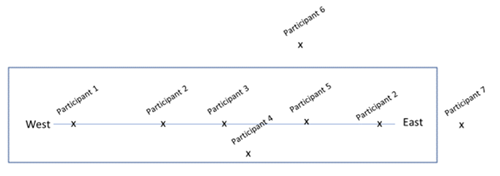The power of giving people time to think in meetings

I have spent the past couple of years helping people in all kinds of organisations make their meetings more productive, inventive and engaging by making the most of everyone involved. And the strikingly consistent feedback from participants in my training workshops has been that the simplest, most transformational change they had made to improve the effectiveness of meetings was to give people time to think (and share their thoughts) before open discussion starts.
Giving people time to think is as simple as it sounds. Rather than launching straight into a discussion about the topic of the session, pose a question to the group: give them some time to think individually about their answer (and ideally write it down); give each an opportunity to voice their answer in turn; and then begin the discussion. This may seem like a slow way to start a discussion, but it’s transformational. Here’s why.
Giving people time to think avoids hierarchy, domination and anchoring effects
One of the most common complaints about meetings is the dominance of a few voices. Sometimes it’s an organisational hierarchy thing – the most senior people feeling the urge to stamp their authority on the direction of the meeting. There are often the ‘usual suspects’, those who always speak up (something I have often been accused of – and, hands-up, probably guilty).
But it’s not just hierarchy and extroverts that are an issue. In an unstructured discussion, the first person to speak effectively sets the starting point for the conversation so that subsequent contributions are received relative to that starting point.
This is known as ‘anchoring’, and it’s a real drag on making the most of everyone. Consider the spectrum below where there is a range of possible ideas/solutions/views about a topic. We’ll represent that range as being from West to East.

If the first person to speak about the topic is towards one end and your view is towards the other, it can be quite hard to make your contribution without setting yourself up in opposition to the expressed view. It immediately creates a potential conflict in making your point. So, you have to be confident and feel psychologically safe to speak up, especially if you haven’t had time to think through your ideas.
If everyone has time to think about their response and put it on the table before the discussion starts, then both hierarchy and anchoring effects are reduced. Other ideas – some of which may even challenge the limitations of the spectrum and drive breakthrough thinking – can be voiced before the discussion starts.

Now the discussion can be address pros and cons, overlaps, synergies between different approaches; crashing together lots of ideas without setting two up in conflict and building from there.
Giving people time to think promotes inclusion
When you give people time to think, they can think at their own speed, in their own way, according to their own cultural norms, in their own language. When everyone thinks and everyone shares their thoughts in turn the barriers to speaking up are reduced, whether those relate to cultural, language, expertise or neurodiversity challenges. Giving people time to think (and respond) is essential to make the most of your hard work in getting diversity in the room to produce the diversity of ideas that the team is capable of.
Giving people time to think promotes active listening
If you’re thinking about what you’re going to say, you’re not properly listening to what’s being said. And if you are listening, are you thinking about what you can say in relation to it? By getting your thinking out of the way before everyone speaks, your brain is free to think about what you’re hearing: all the ideas and how they relate to each other. This can help you find interesting combinations and connections, and make the most what everyone brings. You are free to give quality of attention that is palpable to the speaker.
Giving people time to think helps bring up insights
We’ve all experienced the ‘esprit d’escalier’ – that realisation of what you should have said when asked a question in a meeting; what you wished you’d thought of at the time. In fact, you probably did ‘think’ of it in the meeting – you just didn’t know.
This is result of a subconscious survival instinct. Our brains (or to be more specific a region called the anterior cingulate cortex (ACC)) censor ideas that may lead to us being criticised or ridiculed as it may lead us to be kicked out of the group and left on the plain to be eaten by a sabre-toothed tiger. Our brains haven’t evolved to know the difference between a social threat and a mortal one.
When you leave the room, you are once again safe and that idea you had (but didn’t know you had) comes to the surface. Having time to think without interruption is a great way to quiet the ACC and allow ideas to surface in the moment when they’re useful.
Giving people time to think leads to better ideas and collaborative/creative results
There is a fair amount of research that shows that brainstorming sessions tend to provide fewer and less good ideas than having people do work on their own first. (Google ‘myth of brainstorming’ for a selection.) And this is true not just of brainstorms, but of any meeting where you need to make the most of everyone involved. Which should, of course, be all meetings.
So, next time you’re planning a meeting (you do plan your meetings right?), set aside a little time for participants to think. It’s a big step on the path to making the most of everyone in your meetings, improving projects and team culture.
You may also be interested in:
- Catch the Power of Projects 2022 conference on demand
- Evolving project leadership
- Five tips for making a scrum meeting sing
Images provided by Richard Gold, 2022.


2 comments
Log in to post a comment, or create an account if you don't have one already.
That was as amazing concept. Thanks to the author to bring this up here. I just want to know about how much time is appropriate for thinking.
Hi Atika Apologies for the delayed reply. That's a good question. The answer is that it depends on what you are trying to do. For example, you may (and should) ask people a checking-in question at the beginning of a regular team meeting - in which case just 30 seconds or a minute is plenty to allow them to reflect. If you are running a meeting where you want people to come up with a bunch of ideas, you might give them a few minutes to think about - and ideally write down - their thoughts. Writing down is particularly effective in acheiving the benefits in my post as it takes the thougts out of the head and puts it into the physical world which is a much less risky place from which to share it. (When I run LEGO Serious Play workshops, where peolpe share their ideas through physical models, the ideas go beyond simple words into much richer expressions, which again are much easier to share and to understand and explore the nuances.) And for some meetings it is a good idea to get people to think in a bit more depth before the meeting. Too often, we don't think about how particpants will be able to bring their best thinking to a meeting. Providing some stimulus and specific tasks before a meeting can be really valuable in making the most of everyone's time when together. (Although, this needs to be balanced by another of my Playful Principles® which is "Strong Ideas, Lightly Held", meaning that people bring their best ideas and believe in them, but hold them lightly enough that they really listen to and egage with others' ideas rather than try to defend their own. My Playful Principles for Productive Meetings training workshop brings all 12 Playful Principles together to help level-up how meetings are planned and run.) Hope that's helpful.